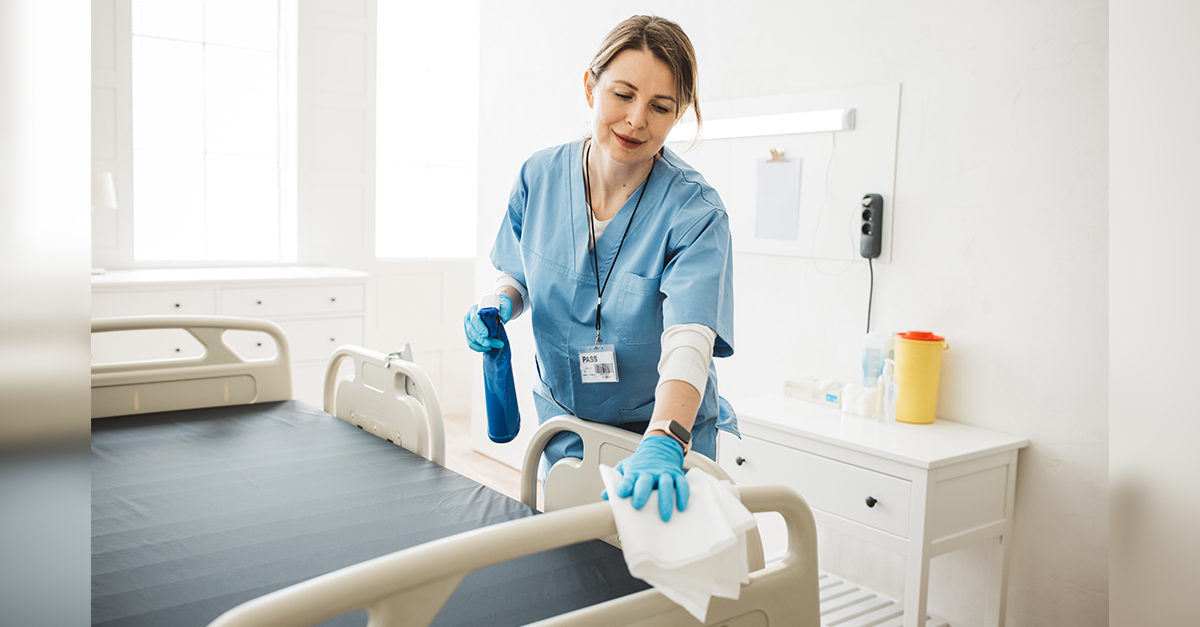A health care facility’s environmental services (EVS) team is one of its best resources for infection control. However, EVS workers, like all humans, are subject to mistakes and weaknesses. Beyond the typical education and training, infection control leaders are looking for new tools to help EVS workers stay on track.
Linda McKinley, RN, a research health scientist at William S. Middleton Memorial Veteran’s Hospital in Madison, Wisconsin, explained how analyzing human factors can reveal gaps in environmental cleaning processes. She offered her ideas on overcoming infection control barriers at the Association for Professionals in Infection Control and Epidemiology’s (APIC’s) Cleaning, Disinfection, and Sterilization Conference, held in November.
Identify the challenges of infection prevention
McKinley started out her presentation listing the three pillars of infection prevention: manual cleaning, hand hygiene, and antibiotic stewardships. These pillars are dependent upon each other to work. “If manual cleaning isn’t done well enough, hand hygiene won’t matter,” she said. “Why do we bother isolating patients and investing in hand hygiene if we won’t clean enough to protect the next patient?”
To highlight the importance of cleaning patient rooms, McKinley referenced a 2022 study by researchers at Johns Hopkins Hospital in Baltimore that found patients had a 27% higher chance of contracting C. difficile (C. diff) if the patient in the room prior to them had the infection. C. diff is a contagious disease that causes diarrhea and colitis and is spread through contact with bacteria on surfaces.
What leads to ineffective cleaning that leaves germs on surfaces? McKinley’s list includes staff turnover, time pressures, and the type of disinfectant chosen, as well as inefficiencies in the manual cleaning process.
Account for cleaning variations
Effective cleaning is contingent on following standards consistently. Unlike autonomous cleaning tools, human cleaning staff cannot be automatically programed to clean the same way every time. Variations in cleaning are natural.
By evaluating human behaviors in following cleaning processes and using tools, infection prevention authorities can help their EVS staff clean more consistently. McKinley offered several examples of cleaning challenges and solutions.
- Challenge: High-cognitive workload and time pressures
Solution: Alleviate mental workload
Example: Implement checklists - Challenge: Delayed feedback and connection with negative results
Solution: Improve feedback and connect with positive results
Example: Offer real-time feedback - Challenge: Lack of cues to follow hygiene procedures
Solution: Sharpen cues
Example: Utilize signage or technology such as hand hygiene badges - Challenge: Complex and inefficient tasks
Solution: Reduce complexity and inefficiency
Example: Implement product designs/redesigns, conduct a task/workflow analysis.
Go with the workflow
Health care facilities that set up a task/workflow analysis can better pinpoint cleaning inefficiencies and find solutions. McKinley recommended breaking down the work system into five categories: tools and technology, organization, physical environment, tasks, and people. Then consider the components and characteristics of each category. For instance:
- Tools and technology: Medical devices, electronic tools such as e-health records, and e-order entry
- Organization: Teamwork, communication, collaboration, culture, work schedules, rewards/incentives, and evaluations
- Physical environment: Building design and layout, noise levels, and temperature
- Tasks: Workload, cognitive load, workflow, and time pressure
- People: Education, skill level, knowledge, motivation, and physical/psychological characteristics.
In a 2016 study at Johns Hopkins Hospital, researchers applied the five categories in a Systems Engineering Initiative for Patient Safety (SEIPS) model to determine patient outcomes in relation to health care-associated infections (HAIs) and overall satisfaction. The researchers analyzed patient room cleaning processes and other patient care procedures, employee outcomes in regard to motivation and satisfaction, and organization outcomes such as reputation and reimbursement. They listed the challenges they found in each of the five categories and offered intervention ideas.
“Even if you don’t do your own work system analysis, this will be a great reference to you if you want to look at environmental cleaning processes in your facility,” McKinley said.
- Under the people category, researchers pinpointed education as a challenge for EVS workers and recommended simulation-based training.
- Under the tasks category, researchers focused on the ambiguity over who cleans what in patient rooms. They recommended redesigning cleaning task lists, making sure the lists are very specific regarding cleaning responsibilities for each surface/part of a room.
- Under the tools and technology category, researchers highlighted poorly designed or ineffective checklists. They advised managers to redesign the checklists with a focus on human strengths and weaknesses.
- Under the environment category, researchers noted that cluttered patient rooms impeded cleaning. They suggested identifying areas to store patient belongings, making the rooms easier to clean.
- Under the organization category, researchers called out the lack of appreciation for EVS workers and the department as a whole. They recommended reorganizing EVS so it is based in each unit instead of being one hospital-wide department. The researchers also suggested that EVS management attend training sessions to gain knowledge and certification that could increase their value within the organization.
Although the Johns Hopkins researchers conducted their analysis solely through observations, another option is to conduct interviews. At William S. Middleton Memorial Veteran’s Hospital, hospital leaders interviewed both employees and patients in completing their SEIPS analysis.
“We dug in a bit deeper and asked, ‘What were the motivations of workers? What was their experience, knowledge, and perception?’” McKinley said. “So, you can go as deep as you want to go.”
Break through infection control barriers
Through a series of employee and patient interviews, infection control leaders at the veteran’s hospital found that patient room cleaning rates were much lower when the patient and/or a visitor was present in the room. “We found that if patients are sitting in a chair near the bed, then EVS workers are able to clean the bed very thoroughly, including the bedrails,” McKinley said. “But if patients are in the bed, workers have to skip cleaning the bed and focus on cleaning the bathroom.”
The interviews also revealed that cleaning was more efficient when workers followed a set pattern, whether it was cleaning top to bottom or clockwise, compared to when workers followed their own pattern. And that EVS staff were dealing with a lot of interruptions. “These interruptions didn’t decrease compliance, but they increased [the worker’s] duration of cleaning, so they were off schedule,” McKinley said.
Patients reported that EVS staff were noticeably uncomfortable cleaning an occupied room and seemed to be rushing through their tasks. EVS staff confirmed their nervousness, explaining that they worried about patient safety. As EVS teams worked with saturated cloths and mops, they worried that wet surfaces could pose a slipping hazard to patients. EVS workers also expressed concern about using cleaning chemicals around patients and worried about dripping cleaning solution from their cloths onto patient beds.
After listening to concerns from both sides, hospital leaders offered some suggestions, such as using disposable wipes rather than saturated cloths for surfaces near the patients, such as bedrails or bed trays. The hospital is also working on improving communication between cleaning staff and patients through the KAIDE2T formula—knock, announce, introduce, duration, engage, explain, and thank. This formula provides a method for EVS staff to announce their presence to patients, explain the importance of cleaning for patient health and safety, and increase the comfort level for both parties.
“Now, hopefully, you have a good idea of how you can do some observations and interviews and see where your gaps are and your entry points for infection control interventions,” said McKinley. “If you know you need to improve the environmental cleaning process at your facility, you can try throwing different solutions at it without evaluating your system. But the evaluation will give you strategies that are targeted for your specific situations.”




